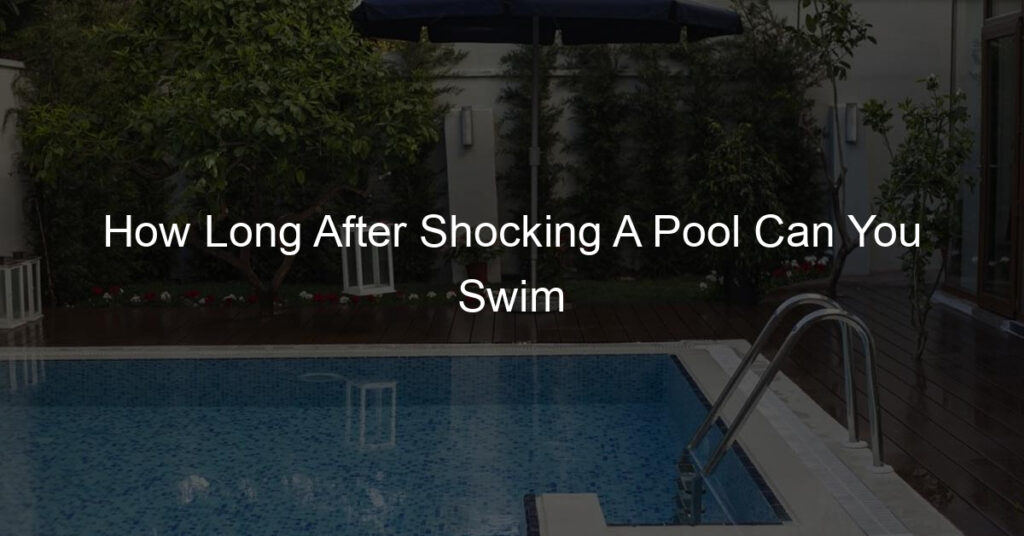Introduction
Are you left wondering, “How long after shocking a pool can you swim?” In this comprehensive guide, we dive deep into everything you need to know about pool shocks and swim safety. We’ll explore the chemical processes involved, different types of pool shocks, the health implications, and many other critical aspects that can influence your post-shock swim time.
Whether you’re a pool owner, a regular swimmer, or someone curious about the topic, this guide will answer your questions and provide you with practical, straightforward information.
Understanding Pool Shock Treatment: The Basics
Pool shocking is a crucial maintenance process that involves adding a high concentration of chemicals (typically chlorine) into the pool. The primary purpose of pool shock is to kill bacteria, algae, and any other contaminants that can compromise the pool’s sanitation. It effectively “shocks” the pool back to a healthy state. This process also helps to clear up cloudy water and prevent potential irritations for swimmers.
Factors Influencing How Long to Wait After Pool Shock
How long to wait before you swim after shocking your pool can depend on several factors. These include the type of shock used, the pool’s chemical balance, and the water temperature. Some shocks may allow you to swim as soon as 15 minutes after treatment, while others require you to wait up to 24 hours. It is crucial to follow the manufacturer’s instructions and to test the pool’s chlorine levels before getting back in.
What is Chlorine Shock: An Essential Guide
Chlorine shock, also known as super chlorination, is a process that involves adding a high dose of chlorine (10 to 20 times the regular amount) to the pool to kill bacteria and algae. It’s a necessary step when the pool has a high demand for chlorine, such as after a large pool party or during hot weather when bacteria and algae grow more rapidly.
The Chemistry Behind Pool Shocking
The science of pool shocking revolves around the concept of “free chlorine”. This term refers to the active chlorine in your pool that can disinfect and oxidize contaminants. When you shock your pool, you aim to raise the free chlorine level to a point where it can break down harmful compounds, a process known as breakpoint chlorination. After the pool shock, the free chlorine levels must return to a safe level (1-3 parts per million) before it’s safe to swim.
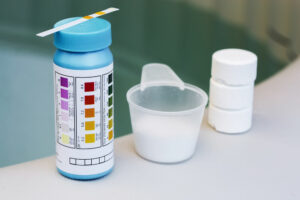
Safety Precautions: When is it Safe to Swim After Shocking?
Determining when it’s safe to swim after shocking your pool is crucial for the health and safety of swimmers. Generally, it’s safe to swim when the free chlorine levels drop to between 1-3 parts per million. Swimming in a pool with high chlorine levels can cause skin, eye, and respiratory irritation, and long-term exposure can lead to more serious health risks. Always test your pool water before swimming after a shock treatment.
Exploring the Different Types of Pool Shock
There are several types of pool shock on the market, each with its own benefits and drawbacks. These include calcium hypochlorite (cal hypo), dichlor, and non-chlorine shocks. Cal hypo is popular due to its high chlorine content and ability to kill algae quickly. Dichlor, on the other hand, is stabilized, meaning it won’t break down as quickly in sunlight, but it can cause your pool’s cyanuric acid levels to rise. A non-chlorine shock is a good option if you need to swim soon after shock, as it allows you to get back in the pool within 15 minutes.
Effects of Pool Shock on Swimmers’ Health
Swimming in a pool before the chlorine levels have normalized can have various health effects. In the short term, high chlorine levels can cause red eyes, itchy skin, and a bleached swimsuit. In more extreme cases, it can lead to difficulty breathing, especially for people with respiratory issues. Long-term exposure to high levels of chlorine can also cause more serious health problems like asthma and other respiratory issues. Always ensure the chlorine levels are safe before swimming.
Key Signs That Your Pool Needs Shocking
Several signs indicate that your pool might need a shock treatment. These include cloudy or green water, a strong chlorine smell, slimy pool surfaces, and burning, red eyes after swimming. Additionally, if you test your pool water and find that the combined chlorine level is higher than 0.5 parts per million, it’s time to shock your pool.
Best Time to Shock a Pool for Optimal Results
The ideal time to shock your pool is in the evening or at night. This is because the sun can burn off unstabilized chlorine, making the shock less effective. By shocking your pool in the evening, you give the chlorine the entire night to work without interference from the sun, and it should be safe to swim by morning if the chlorine levels have returned to normal.

The Role of Temperature in Pool Shock Effectiveness
Water temperature plays a significant role in the effectiveness of a pool shock. Chlorine reacts faster in warm water, making the shock process quicker. However, this can also mean that the chlorine gas off-gasses at a faster rate, which can make the shock less effective if not properly managed. It’s best to follow the manufacturer’s instructions regarding the optimal temperature for the shock product you’re using.
How to Shock a Saltwater Pool: Steps and Precactions
Shocking a saltwater pool is similar to a regular pool but requires a slightly different process. Since saltwater pools generate their own chlorine, it’s essential to ensure the chlorine generator is off during the shock process. You’ll still need to use a chlorine-based shock, but you may need less than in a regular pool. Follow the manufacturer’s instructions, and make sure to test the water before swimming.
Maintaining Pool Chemical Balance After Shocking
After shocking your pool, it’s important to rebalance the water to ensure it’s safe for swimming. This involves testing the water for its pH, alkalinity, and calcium hardness levels, and adjusting as necessary. A well-balanced pool has a pH between 7.2 and 7.8, alkalinity between 80 and 120 parts per million, and calcium hardness between 200 and 400 parts per million.
Pros and Cons of Using Non-Chlorine Shock
Non-chlorine shocks have several benefits, such as allowing you to swim soon after application and being less harsh on vinyl liners. However, they also have drawbacks. For instance, they’re not as effective at killing algae and bacteria as chlorine shocks, so you might need to use them more frequently or in conjunction with other sanitizers. They can also be more expensive than traditional chlorine shocks.
DIY Guide: How to Shock Your Pool Correctly
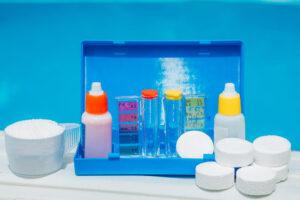
Shocking your pool correctly is essential for maintaining a safe and clean swimming environment. Start by testing your pool water to determine if a shock is necessary. Then, choose the right shock product for your needs and follow the manufacturer’s instructions carefully. Always add the shock to water (not the other way around) to prevent a dangerous reaction. Let the pump and filter run for at least 8 hours or overnight to thoroughly circulate the shock. Finally, retest the water before swimming to ensure it’s safe.
Myths and Facts About Swimming Immediately After Pool Shock
One common myth is that you can swim immediately after a pool shock. However, this is typically not thecase and can be dangerous due to high chlorine levels. Another misconception is that a strong chlorine smell indicates a clean pool. In fact, a strong chlorine smell often means there are too many chloramines, signaling the need for a shock. Always rely on water testing rather than myths when deciding when to swim after shocking.
Preventing Algae Growth: Post-Shock Pool Care
After shocking your pool, proper care can prevent the regrowth of algae and bacteria. This includes maintaining your pool’s chemical balance, regularly cleaning your pool and its filter, and keeping the water circulation in good condition. Additionally, regular brushing of the pool walls can prevent algae from adhering and growing.
The Impact of Pool Shock on Pool Liners and Equipment
High levels of chlorine during a shock treatment can potentially damage pool liners and equipment over time. Over-chlorination can cause liners to fade and become brittle. Equipment such as pumps and filters may also be affected. It’s important to use the correct amount of shock and to ensure chlorine levels return to normal after the treatment to minimize potential damage.
Is it Safe for Pets to Swim After Pool Shocking?
Just like humans, pets should not swim in a pool immediately after shocking. High levels of chlorine can irritate their skin and eyes, and ingestion of highly chlorinated water can cause gastrointestinal issues. Always test the water before allowing pets to swim and make sure they have a clean source of drinking water available.
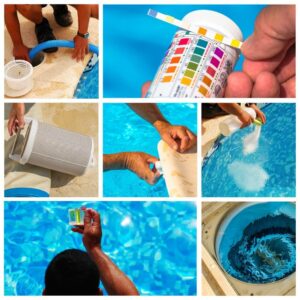
Ideal Pool Shock Frequency for Healthy Swimming Environment
The frequency of pool shock treatments depends on factors like the pool usage, weather conditions, and test results. Generally, a pool should be shocked at least once a week during the swimming season, or more frequently if the pool is heavily used, after heavy rain, or during periods of hot weather. Regular water testing is the best way to determine when a shock treatment is necessary.
Understanding the Role of pH Levels Post Pool Shocking
The pH level of your pool plays a crucial role in the effectiveness of a shock treatment. An ideal pH level is around 7.2 to 7.6. If the pH is too high, the chlorine becomes less effective, and if it’s too low, the chlorine will dissipate too quickly. After a shock treatment, the pH level can fluctuate, so it’s essential to test and adjust as necessary before swimming.
Comparison of Different Types of Pool Shock
| Type of Shock | Active Ingredient | Wait Time Before Swimming | Effectiveness Against Algae | Impact on pH Level |
|---|---|---|---|---|
| Cal Hypo | Calcium Hypochlorite | Up to 8 hours | High | Increases pH |
| Dichlor | Sodium Dichloro-S-Triazinetrione | Up to 8 hours | Medium | Stabilizes pH |
| Non-chlorine Shock | Potassium Monopersulfate | 15 minutes | Low | Little to no effect on pH |
Conclusion
Understanding the process of pool shocking and the subsequent safety precautions is crucial for maintaining a healthy swimming environment. This comprehensive guide has equipped you with all the necessary information, from the science behind pool shocking to different types of pool shocks, and from recognizing when your pool needs a shock treatment to the safety measures for swimming post-treatment. Remember, maintaining a clean, well-balanced pool ensures the best and safest swimming experience for everyone.
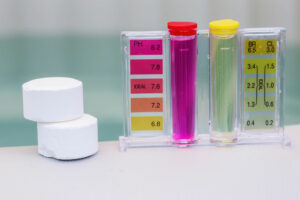
Delving Deeper: Unexplored Corners of Pool Shocking
The Impact of Pool Size on Shock Quantity
It’s essential to recognize that pool size plays a significant role in determining the amount of shock needed. A larger pool requires more shock, while a smaller pool requires less. Using the correct amount of shock for your pool size ensures the most effective treatment without over-chlorinating the water.
The Importance of Pool Covers in Shock Effectiveness
Pool covers can greatly enhance the effectiveness of a shock treatment. By preventing sunlight from reaching the water, pool covers stop the sun from burning off chlorine, allowing the shock to work more effectively. Using a pool cover after shocking, especially during the day, can lead to better results.
Shock Treatments and the Environment
Pool shocks, particularly chlorine-based ones, can have an impact on the environment. High levels of chlorine can harm plants and wildlife if the water is splashed out of the pool or if it drains into the surrounding area. Using environmentally friendly shocks or taking precautions to minimize spillage and drainage can help mitigate this impact.

